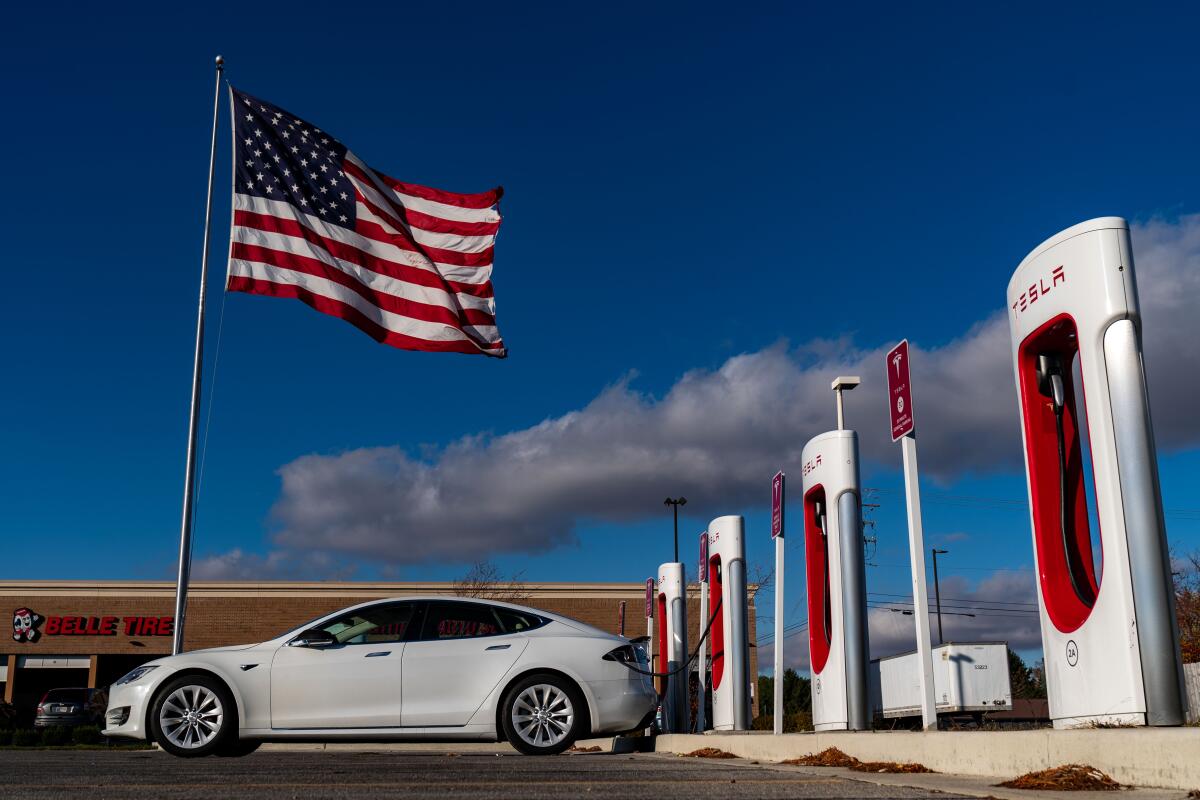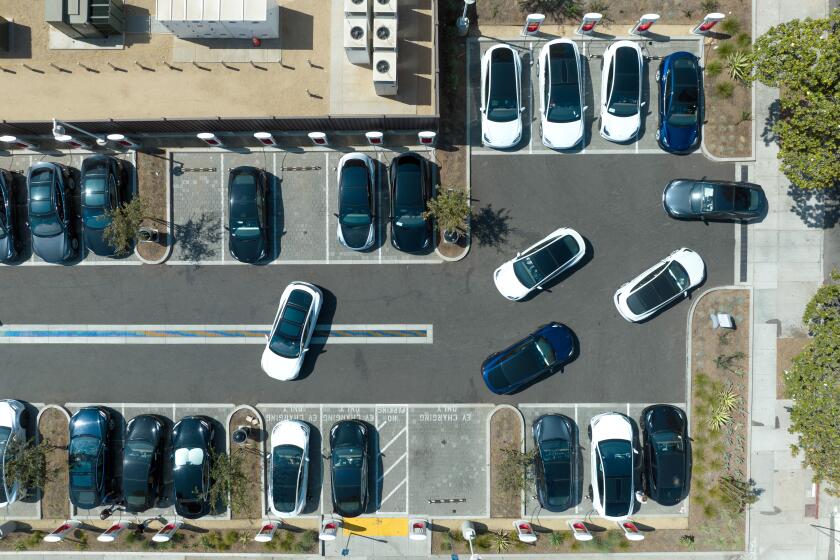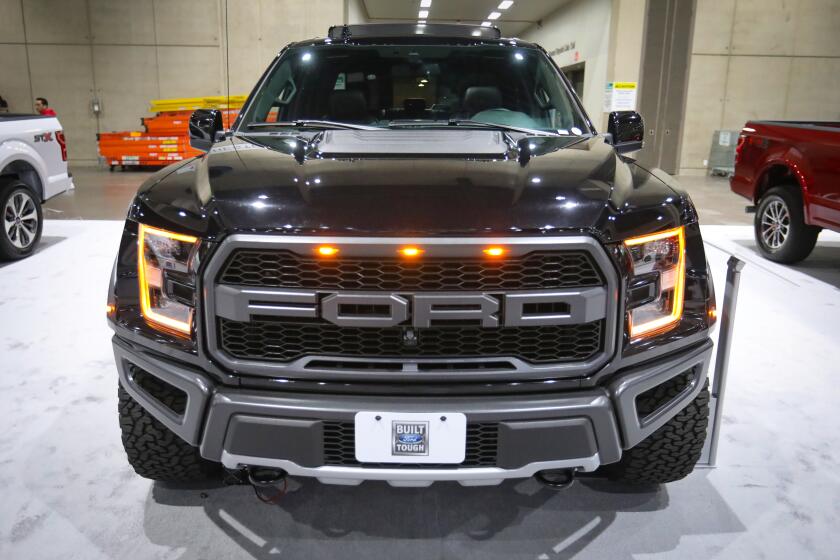Editorial: Can you afford an EV? Good luck, with so few models eligible for new tax credit

If you’re in the market for a new car, wouldn’t you be more likely to buy a climate-friendly electric model if you could save thousands of dollars off the sticker price?
That’s the idea behind generous electric vehicle subsidies authorized as part of the Inflation Reduction Act passed by Congress last year, which are supposed to accelerate the fight against climate change by making zero-emission cars more affordable. But that’s a far cry from what’s likely to happen. Under complicated new rules released Friday by the Treasury Department, only a handful of more than 90 electric car models for sale in the U.S. will be eligible for incentives that allow car buyers to claim a tax credit of up to $7,500.
For that you can thank U.S. Sen. Joe Manchin III (D-W.Va.). Restrictions on sourcing battery parts and critical minerals were added to the legislation in order to win his support and, at least theoretically, encourage domestic manufacturing and reduce the electric vehicle supply chain’s dependence on China. Since Jan. 1 vehicles have had to be assembled in North America and cannot cost more than $55,000 (or $80,000 for trucks and SUVs) to qualify for the full credit.
To be eligible under the new standards, they’ll also have to be built with specific percentages of materials from the U.S. or countries with which the U.S. has a free trade agreement. This year, at least 40% of the value of battery minerals must be extracted or processed in the U.S. or its trade partner countries, or derived from materials recycled in North America, increasing annually until reaching 80% in 2027, while at least 50% of the value of battery components have to be manufactured or assembled in North America until hitting 100% in 2029.
Nearly 1 in 5 new car sales in California were zero-emission in 2022, but most of them are Teslas and other high-end models. That shows how far the state has to go in making the shift to electric vehicles equitable.
These hurdles are beyond disappointing, both in terms of climate action and consumer friendliness. It’s hard enough to purchase a car without having to sift your choices through an eligibility list based on complex sourcing requirements that get more stringent every year. Car buyers should be given unequivocal and simple incentives to go electric, but instead they’ll encounter confusion and uncertainty. There’s no question these obstacles will slow progress cutting pollution that’s fouling the air and fueling global warming and will blunt the effectiveness of the nation’s biggest climate legislation to date.
While the list of vehicle models that meet the new standards won’t be available until later this month, some carmakers have already announced qualifying models based on the rules. For example, Tesla said the lowest-priced version of its Model 3, the bestselling car in California, will not be eligible for the full credit under the new battery-sourcing requirements, but General Motors said the Cadillac Lyriq, Chevrolet Equinox EV SUV and Blazer EV SUV will qualify fully. Bottom line: Fewer EV models qualify for the full $7,500 tax credit, some will only be eligible for $3,750, and many will get no incentives at all.
The Biden administration argues that while the number of eligible models will be small at first, over time the standards will push automakers to manufacture EVs and parts in the U.S., strengthen the domestic supply chain and create clean energy jobs.
Encouraging vehicle and battery production by the U.S. and its partners is a worthy long-term goal. But with climate change, we don’t have the luxury of time and need to switch to electric cars as quickly as possible. We aren’t on track to meet our climate goals as it is, and these kinds of onerous obstacles make us less likely to achieve President Biden’s goal of making half of new car sales zero-emission by 2030.
California lawmakers are considering a proposal that could charge car owners a fee for registering heavier vehicles. It’s a small but important step.
EV adoption has started to pick up, with plug-in vehicles accounting for nearly 6% of new U.S. sales in 2022 and nearly 1 in 5 in California. But their higher prices still put them out of reach for many households. Nationwide, new EVs sell for about $10,000 more, on average, than gas-powered models. That disparity hurts lower- and middle-income Americans, who are missing out on the benefits of EVs, including cleaner air and savings from lower fuel and maintenance costs.
Lawmakers ought to draft clean-up legislation to loosen and simplify tax credit rules so that buyers aren’t limited to such a short, ever-changing list of vehicles to take advantage of the tax credit. But that seems unlikely, with Manchin blasting the rules released Friday as not stringent enough, the House controlled by Republicans and scores of senators and House members beholden to fossil fuel industries who benefit from a slow transition to electric cars. Perhaps there’s a way for regulators to ease the rules without the need for new legislation.
For the Inflation Reduction Act to deliver climate action and garner public support, it needs to be rolled out seamlessly and the benefits widely felt. If the EV tax credit rules are any indication of what’s to come, the transition to zero-emission economy is in real trouble.
More to Read
A cure for the common opinion
Get thought-provoking perspectives with our weekly newsletter.
You may occasionally receive promotional content from the Los Angeles Times.












